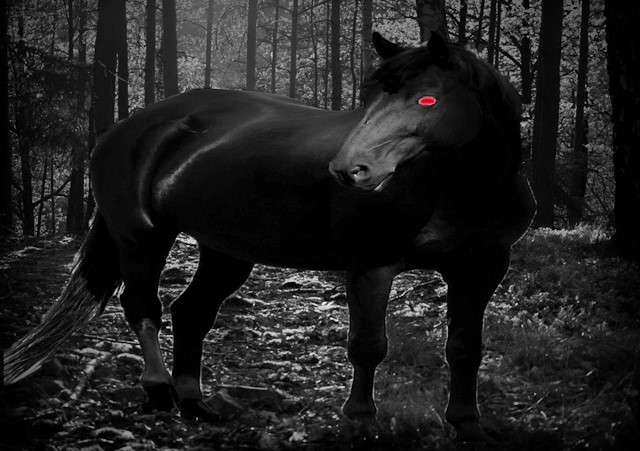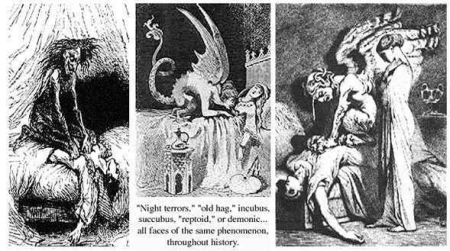
A character’s “night life” can provide depth to the characterization and understanding for the reader. Nightmares and night terrors are both frightening, but the two sleep disorders are frightening in different ways to very different audiences. Knowing the distinctions will help you use them effectively in your writing.

Adequate sleep, with all the different stages and cycles, is a crucial part of overall physical and mental well-being. Dreaming is absolutely necessary to good mental health. There is far too much detail to get into here, but research is clear. Indeed, repeatedly waking someone to prevent dreaming is a well-known form of torture.
What Are Nightmares?

Japanese Folklore

Nightmares are vividly realistic, disturbing dreams that rattle a person awake from a deep sleep. They often affect the body in the same way waking danger does. Adrenaline spikes, heart rate and respiration rate increase, and the body increases sweat production.

Nightmares tend to occur most often during rapid eye movement (REM) sleep, when most dreaming takes place. Because periods of REM sleep become progressively longer as the night progresses, people experience nightmares most often in the early morning hours.

Some people wake from nightmares crying, while others may wake shaking from fear. After a nightmare, people often have trouble falling back to sleep. The combination of the stress hormones flooding through the body with whatever lingering images from the nightmare are stuck in the mind make it very difficult to relax enough to fall back asleep. Particularly disturbing nightmares can cause sleep disruptions for days and stick around in the brain for years.
What are Night Terrors?

Night terrors are recurring nighttime episodes that happen while a person remains asleep. They’re also commonly known as sleep terrors. When a night terror begins, a sleeper will appear to wake up. They might call out, cry, move around, or show other signs of fear and agitation.

Other common reactions:
- Screaming or crying
- Staring blankly
- Flailing or thrashing in bed
- Breathing rapidly
- Having an increased heart rate
- Becoming flushed and sweaty
- Seeming confused
- Getting up, jumping on the bed, or running around the room

A sleeper may become aggressive if a partner or family member tries to restrain them or keep them quiet. The episode can last for a few seconds or up to several minutes, though the sleeper typically doesn’t wake up. Most people fall right back to quiet sleep after a night terror.

by Tsukioka Yoshitoshi
Night terrors are more common in young children, but they can disturb adults as well. An estimated 2 percent of adults also experience night terrors. In reality, this number may be higher, since people often don’t remember having night terrors.
Night terrors usually happen earlier in the night, during the first half of the sleeping period. This is when a sleeper is in stages 3 and 4 of non-rapid eye movement (NREM) sleep, also called slow-wave sleep. It’s uncommon to have them twice in one night, though it can happen.
What is the Difference Between Night Terrors and Nightmares?

Night terrors may might seem similar to nightmares, but the two are different. In addition to the immediate mental and physical effects, the effect on witnesses or other members of a household are very different for night terrors and nightmares.

When a sleeper wakes up from a nightmare, they will probably remember at least some of what the dream involved. Come morning, the sleeper is quite likely to remember the episode, though the memory may be vague.
During night terrors, the sleeper remains asleep and usually doesn’t remember what happened when they do wake up in the morning. The sleeper might remember a scene from a dream they had during the night terror episode, but it’s uncommon to recall any other part of the experience.

A partner, roommate, family member, or other witness to a night terror episode is likely to remember the experience quite well. The daughter of a friend has fairly frequent night terrors, during which she will wander out of the house in her pyjamas or physically attack her partner in his sleep. In the morning, she occasionally has grass on her feet or bruised knuckles but no memory of how she got them.
What Causes Sleep Disorders?


Many adults who experience nightmares or night terrors live with mood-related mental health conditions, such as depression, anxiety, or bipolar disorder. Night terrors have also been associated with the experience of trauma and heavy or long-term stress.
Physical factors can also contribute to the frequency of night terrors and nightmares. Sleep apnea is a very common cause of other sleep disorders. Some other possible causes

- Travel-related sleep disruptions
- Restless leg syndrome
- Sleep deprivation
- Medications, including stimulants and some antidepressants
- Fever or illness
- Alcohol use
Frequent disruptions to sleep cycles (such as night terrors or nightmares) cause fatigue and, eventually, sleep deprivation. Fatigue and sleep deprivation increase the likelihood of having night terrors or nightmares. There’s no escape!

Bottom Line for Writers: Characters can be just as interesting when they sleep! Why would your character have disrupted sleep, and how would they react? Would the sleep disruption be more effective if experienced by the narrator (nightmare or confusion after night terrors) or by someone close to the narrator (night terror or discussing remembered nightmare)?

